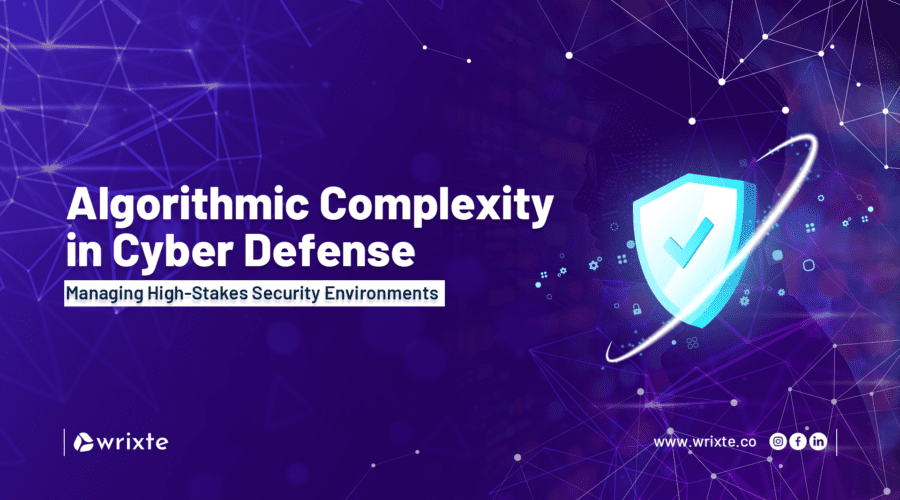The sophistication of cyber threats has escalated dramatically in today’s business world, necessitating equally advanced defense mechanisms. The cornerstone of modern cybersecurity strategies is increasingly built upon complex algorithms, particularly in high-stakes environments where the cost of a breach can be catastrophic. This blog explores the nuances of algorithmic complexity in cyber defense, also looking into how organizations can manage and leverage these advanced technologies to safeguard their digital assets.
The Rise of Complex Algorithms in Cybersecurity
The integration of complex algorithms into cybersecurity frameworks has become essential for addressing the growing variety and sophistication of cyber threats. These algorithms, often rooted in advanced mathematics and computer science, are designed to identify, analyze, and respond to threats with unprecedented precision. For example, machine learning algorithms can process vast amounts of data to identify patterns indicative of malicious activity, while cryptographic algorithms protect data integrity and confidentiality.
A key aspect of this complexity lies in the diversity of algorithms employed. From heuristic-based approaches that utilize experience-based techniques to probabilistic models that calculate the likelihood of future events, the landscape is vast and intricate. Each algorithm type serves specific functions, such as anomaly detection, behavioral analysis, or encryption, contributing to a robust defense strategy.
Challenges of Managing Algorithmic Complexity
While complex algorithms are powerful tools in cyber defense, they also present significant challenges. One of the primary issues is the computational cost associated with implementing and running these algorithms. High computational demands can strain resources, requiring significant investment in hardware and infrastructure. Additionally, the development and maintenance of these algorithms require specialized knowledge and expertise, often making it difficult for organizations to keep pace with evolving threats.
Moreover, the complexity of these algorithms can sometimes lead to unintended consequences, such as false positives or negatives. For instance, an overly sensitive anomaly detection system might flag benign activities as threats, leading to unnecessary investigations and resource allocation. Conversely, an algorithm with low sensitivity might miss actual threats, leaving the system vulnerable.
Key Algorithms in Modern Cyber Defense
Machine Learning and AI: Machine learning algorithms are pivotal in modern cybersecurity, particularly in identifying and predicting new threats. Techniques such as supervised learning, unsupervised learning, and deep learning enable systems to learn from data, adapt to new threats, and improve over time. For example, neural networks can identify complex patterns in network traffic that may indicate a cyber attack, even if the attack vector is previously unknown.
Cryptographic Algorithms: Cryptography remains a foundational element of cybersecurity, protecting data from unauthorized access and ensuring secure communication. Algorithms such as RSA, AES, and Elliptic Curve Cryptography (ECC) are widely used to encrypt data, ensuring its confidentiality and integrity. The complexity of these algorithms is vital for resisting attacks, such as brute force or cryptanalysis.
Heuristic and Anomaly Detection Algorithms: These algorithms are used to detect unusual patterns or behaviors that may indicate a security breach. Heuristic algorithms rely on rules and experience-based techniques, while anomaly detection uses statistical models to identify deviations from normal behavior. Both approaches are essential for identifying novel threats that do not match known signatures.
Strategies for Managing Algorithmic Complexity
Resource Optimization: To manage the computational demands of complex algorithms, organizations can optimize resources through cloud computing or specialized hardware like GPUs and TPUs. This allows for scalable and efficient processing of large datasets.
Continuous Learning and Adaptation: Given the dynamic nature of cyber threats, algorithms must continuously learn and adapt. Implementing feedback loops and machine learning models that evolve based on new data can help maintain effectiveness over time.
Collaboration and Knowledge Sharing: Sharing knowledge and collaborating with other organizations, researchers, and cybersecurity professionals can accelerate the development of effective algorithms and strategies. This collaborative approach also helps in staying updated with the latest threat trends and mitigation techniques.
Transparency and Explainability: As the complexity of algorithms increases, ensuring transparency and explainability becomes crucial. This helps in understanding how decisions are made and provides a basis for refining and improving algorithms.
Balancing Sensitivity and Specificity: Fine-tuning algorithms to balance sensitivity (identifying true threats) and specificity (reducing false alarms) is essential. This balance helps in efficiently allocating resources and minimizing the risk of missing critical threats.
Conclusion
The growing complexity of cyber threats necessitates the use of equally complex algorithms in cybersecurity. While these advanced algorithms offer significant advantages, they also present challenges that organizations must navigate carefully. By optimizing resources, fostering continuous learning, and balancing algorithmic sensitivity and specificity, businesses can harness the power of complex algorithms to protect their digital assets effectively. As cyber threats continue to evolve, staying ahead with cutting-edge algorithmic strategies will be crucial for maintaining robust cybersecurity defenses.
